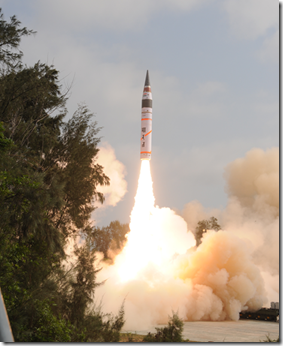India’s long-range nuclear-capable Agni V being launched Thursday (Pic: The Defence Research and Development Organisation)
The successful launch of India’s nuclear-capable long-range Agni V missile on Thursday seems to be prompting some amusing reactions in China.
The Agni V, with a range of 5000 kilometers (about 3125 miles) lifts India into the exclusive club of countries that possess long-range missiles, including China, Britain, France, Russia and the United States.
At least one newspaper op-ed vindicates my path-breaking theory that missile programs everywhere are fueled by dick envy among their male leaders. The state-run Global Times of China pointed out, “India announced a test of its long-range nuclear-capable Agni V missile. The missile has a range of over 5,000 kilometers, meaning it could reach China. India apparently is hoping to enter the global intercontinental missile club, despite intercontinental ballistic missiles (ICBMs) normally having a range of over 8,000 km.” The same article also said that India stands "no chance in an overall arms race."
The implied reminder by the newspaper to India that unless it has intercontinental missiles that reach 8000 kilometers or 5000 miles it should not yet consider itself a member of the club proves my theory. (At this point I have to remind you that my tongue is firmly in my cheek.)
India’s Prime Minister Manmohan Singh, who has lately become a shadow of his own former shadow of his real self, said “Today’s successful Agni-V test launch is another milestone in our quest to add to the credibility of our security and preparedness and to continuously explore the frontiers of science. The entire nation stands together in honouring the achievements of our scientific community who have done the country proud.”
What is it about weapons, especially massively protruding ones like intercontinental ballistic missiles, that compels leaders to equate their success with national pride? Only last week we witnessed how the failure of North Korea’s rocket caused widespread disappointment inside the country, particularly in the mind of its young new leader Kim Jong-un. There are already apprehensions that in order to compensate for the rocket failure, Pyongyang might conduct a nuclear test. In short, there has to be some controlled fire and explosion to make nations feel good.
The United States has been understandably understanding about India’s launch. Asked before Thursday’s launch State Department deputy spokesman Mark Toner said, “Naturally, I just would say that we urge all nuclear-capable states to exercise restraint regarding nuclear capabilities. That said, India has a solid nonproliferation record. They’re engaged with the international community on nonproliferation issues. And Prime Minister Singh, I believe, has attended both the nuclear – both of the nuclear summit – security summits, the one in Washington and then Seoul.” In short, Washington is telling New Delhi, “Please don’t if you can help it, but do if you must.” New Delhi replies, “We must and we did.”
In terms of specifics, the Agni V’s range falls 500 kilometers or about 300 miles short of what is widely considered as the minimum range of an ICBM. India has maintained it is not developing ICBMs because its threat perception so far requires only intermediate-range ballistic missiles (IRBMs). The current range allows India to hit targets deep inside China as well as all of Pakistan.

Leave a comment